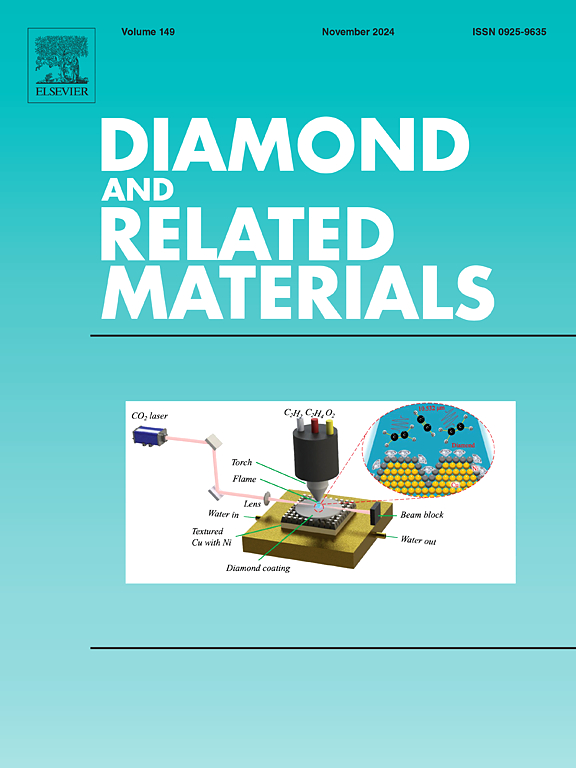二元掺杂对DLC涂层键合结构和力学性能的调制:分子动力学模拟
IF 4.3
3区 材料科学
Q2 MATERIALS SCIENCE, COATINGS & FILMS
引用次数: 0
摘要
类金刚石(DLC)涂层是活塞环-缸套(PRCL)系统中最有前途的耐磨材料之一。然而,它们的广泛应用受到附着力差和内应力高的限制。在这项研究中,我们采用分子动力学(MD)模拟来研究掺杂二元亲碳元素(Si/Cr)的DLC涂层在不同原子分数下的性能。采用径向分布函数(RDF)、配位数(CN)、纳米压痕、剪切应变和von Mises应力分布分析了复合材料的键合结构和力学性能。结果表明,S10样品的sp3杂化率降至66.9% (si10 at.%)。S2样品(cr10 at.%)的硬度和弹性模量最高,分别达到110.03 GPa和244.15 GPa,比纯DLC (S1)样品分别提高了31.9%和18.4%。S7样品(Cr 4 at。%, Si 6 at.%)的H/ES比最高(0.441),比S1(纯DLC)高22.5%,表明其耐磨性增强,塑性变形敏感性降低。纳米压痕后的剪切应变和von Mises应力分布显示了材料的各向同性行为和半球形剪切应变扩散。值得注意的是,S7样品显示出最低的von Mises应力(134.5 GPa),相对于纯DLC降低了69%。综上所述,与未掺杂的DLC相比,二元掺杂(Si/Cr)显著改善了DLC涂层的力学性能、耐磨性、剪切应变分布和von Mises应力响应。综合考虑耐磨性和抗塑性变形性能,S6涂层表现出最佳性能。本研究为提高DLC涂料在工业应用中的性能和适用性提供了有价值的见解。本文章由计算机程序翻译,如有差异,请以英文原文为准。
Modulation of bonding structure and mechanical properties of DLC coatings by binary doping: Molecular dynamics simulation
Diamond-like carbon (DLC) coatings are among the most promising wear-resistant materials for piston ring-cylinder liner (PRCL) systems. However, their widespread application is limited by poor adhesion to substrates and high internal stresses. In this study, we employed molecular dynamics (MD) simulations to investigate the properties of DLC coatings doped with binary carbophilic elements (Si/Cr) at varying atomic fractions. The bonding structure and mechanical properties were analyzed using radial distribution function (RDF), coordination number (CN), nanoindentation, shear strain, and von Mises stress distributions. The results show that the sp3 hybridization fraction decreased to 66.9 % in the S10 sample (Si 10 at.%). The S2 sample (Cr 10 at.%) exhibited the highest hardness and elastic modulus, reaching 110.03 GPa and 244.15 GPa, respectively—an improvement of 31.9 % and 18.4 % compared to the pure DLC (S1) sample. The S7 sample (Cr 4 at.%, Si 6 at.%) achieved the highest H/ES ratio (0.441), which was 22.5 % higher than that of S1(pure DLC), indicating enhanced wear resistance and reduced susceptibility to plastic deformation. Shear strain and von Mises stress distributions after nanoindentation revealed isotropic material behavior and hemispherical shear strain diffusion in the doped samples. Notably, the S7 sample exhibited the lowest von Mises stress (134.5 GPa), 69 % reduction relative to pure DLC. In conclusion, binary doping (Si/Cr) significantly improved the mechanical properties, wear resistance, shear strain distribution, and von Mises stress response of DLC coatings compared to undoped DLC. Considering both wear resistance and plastic deformation resistance, the S6 coating demonstrated optimal performance. This study provides valuable insights for enhancing the performance and applicability of DLC coatings in industrial applications.
求助全文
通过发布文献求助,成功后即可免费获取论文全文。
去求助
来源期刊

Diamond and Related Materials
工程技术-材料科学:综合
CiteScore
6.00
自引率
14.60%
发文量
702
审稿时长
2.1 months
期刊介绍:
DRM is a leading international journal that publishes new fundamental and applied research on all forms of diamond, the integration of diamond with other advanced materials and development of technologies exploiting diamond. The synthesis, characterization and processing of single crystal diamond, polycrystalline films, nanodiamond powders and heterostructures with other advanced materials are encouraged topics for technical and review articles. In addition to diamond, the journal publishes manuscripts on the synthesis, characterization and application of other related materials including diamond-like carbons, carbon nanotubes, graphene, and boron and carbon nitrides. Articles are sought on the chemical functionalization of diamond and related materials as well as their use in electrochemistry, energy storage and conversion, chemical and biological sensing, imaging, thermal management, photonic and quantum applications, electron emission and electronic devices.
The International Conference on Diamond and Carbon Materials has evolved into the largest and most well attended forum in the field of diamond, providing a forum to showcase the latest results in the science and technology of diamond and other carbon materials such as carbon nanotubes, graphene, and diamond-like carbon. Run annually in association with Diamond and Related Materials the conference provides junior and established researchers the opportunity to exchange the latest results ranging from fundamental physical and chemical concepts to applied research focusing on the next generation carbon-based devices.
 求助内容:
求助内容: 应助结果提醒方式:
应助结果提醒方式:


